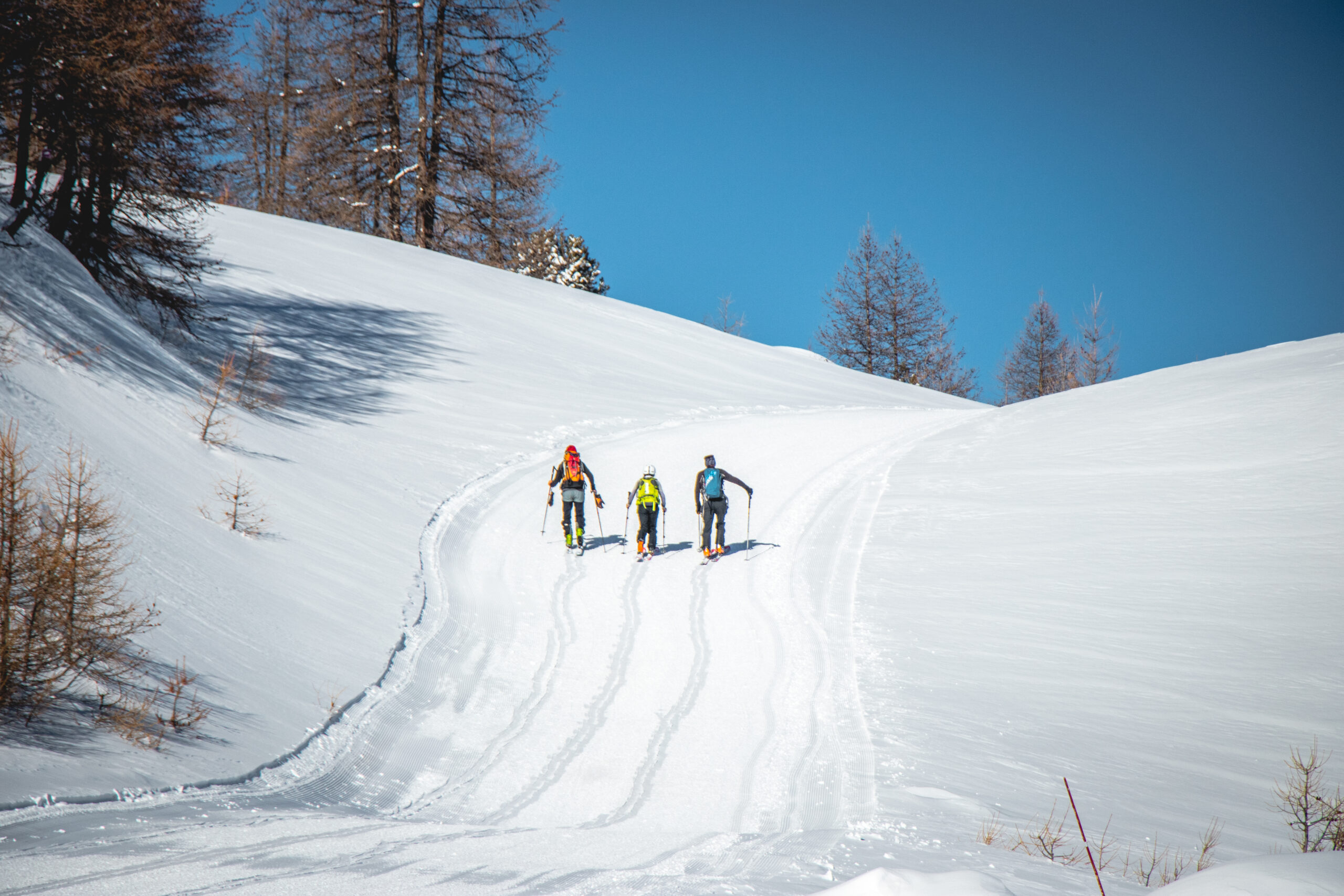
The checklist for ski touring
Want to draw your own line away from the lifts? We understand you. Off-piste ski touring is pure adventure, virgin snow, immaculate landscapes.
But be careful: the mountains don’t give gifts.
The best advice we can give you: ask the guide office or a ski school. And above all, go accompanied by a mountain professional (guide or qualified instructor). They know the terrain, the conditions, the pitfalls to avoid — and most importantly, they will allow you to enjoy safely.
No tourist attractions in sight. Perhaps our site is taking a little nap…
Preparing your ski touring equipment
On the ski side
Ski touring requires specific equipment:
- Touring or splitboard skis (for snowboarders), with free-heel bindings on the way up and blocked on the way down.
- Some bindings offer climbing cleats, useful on steep slopes.
- The skins, glued under the skis, prevent you from backing up on the way up.
- A pair of classic or telescopic poles, essential for keeping balance, especially when going uphill. The telescopic models allow the length to be adapted to the terrain.
Safety equipment
For any outing outside the secure routes, it is essential to leave:
- An avalanche transceiver (Avalanche Victim Detector).
- A shovel (metal, not plastic)
- A probe (aluminum or carbon, light and resistant)
- A charged phone, stored in an easy-to-access pocket. The emergency number is 112.
- A first aid kit
- Bonus: an airbag bag, although expensive, can increase your chances in the event of an avalanche. It remains optional but recommended for committed outings.
Our advice
- Choose a good avalanche transceiver, with a wide field of research (3-antenna models have become the norm)
- Always use new and good quality batteries . The avalanche transceiver must display at least 90% battery at the start.
- During the search, keep your phone more than 30 cm away from the avalanche transceiver to avoid interference.
- Probe with gloves : you stay warm and prevent ice from forming on the probe, which could block it.
- And above all… Work out. Again and again. The day you need your gear, it’s not going to be for a demo — it’s going to be to save a life.
Choosing an outfit adapted to the effort
Layering
Opt for a breathable, layered outfit:
- A thermal first layer, ideally in thermo-regulating merino wool that limits odors
- An insulating layer (fleece or light down jacket)
- A waterproof and windproof jacket
Accessories not to be forgotten
- Sunglasses for the ascent, ski goggles for the descent
- Thin gloves for effort, warm mittens for stopping or descending
- Headband or hat, to be adapted according to the temperature
- Ski helmet, to attach to the bag on the way up and on the way down
Comfort and autonomy
- Comfortable backpack, with adjustable straps and accessible pockets, allows you to carry everything without unbalancing your walk
- Water bottle or hot tea
- Energy bar, dried fruit, or chocolate : a welcome gourmet break at the top
- IGN map or offline GPS app
- Survival blanket
- Charged headlamp
Preparing for your ski touring outing
Training on a marked route
In Pra Loup, you can learn to ski touring in complete peace of mind thanks to marked routes specially designed to start safely. The principle is simple: you go up at your own pace with the sealskins on secure tracks, then you go down quietly by the slopes. A great way to discover the practice without venturing off the beaten track.
These courses are accessible throughout the opening time of the ski area, generally from mid-December to mid-April, depending on the snow conditions. And to make the climb easier, some sections can be lightly groomed, without distorting the hiking experience.

“Alpine” itinerary

“Elite” itinerary

“Open” itinerary
Checks the conditions
- Choose your route according to your level
Find out about the difficulty, the difference in altitude, the distance and the access conditions. In Pra Loup, start with a marked route if you are a beginner. - Check the weather and avalanche bulletin (BRA)
Never leave without being aware of the weather conditions and the risk of avalanches. This influences your equipment, your departure time… or even the decision to postpone your release. - Prepare your equipment the day before
Check that all your equipment is complete and in good condition: skis, skins, avalanche transceiver (with new batteries), clothes, snacks, water, etc. Bring something to repair a fastener or change a skin in case of a problem. - Test your avalanche transceiver before you go
Activate your avalanche victim detector and cross-test with your partners to make sure everything is working. - Tell someone about your itinerary
Inform a friend or family member of your route and estimated time of return. In case of a problem, this will facilitate the search. - Leave early in the day
Snow conditions are safer in the morning, and you will avoid descents in transformed snow or the risks associated with the evolution of the snowpack in the afternoon. - Adapt your pace and take breaks
The ascent in skins is endurance. Drink regularly, eat snacks, and adjust your effort to save energy for the descent.